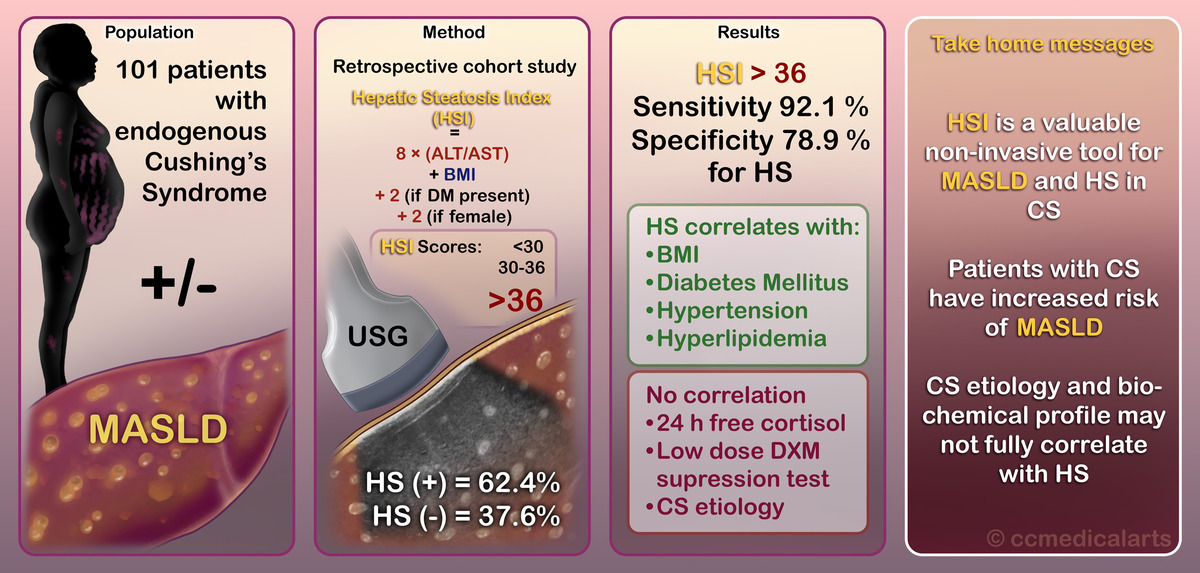Current issue
Archive
Manuscripts accepted
About the Journal
Editorial office
Editorial board
Section Editors
Abstracting and indexing
Subscription
Contact
Ethical standards and procedures
Most read articles
Instructions for authors
Article Processing Charge (APC)
Regulations of paying article processing charge (APC)
HEPATOLOGY / RESEARCH PAPER
Assessing Hepatosteatosis in Endogenous Cushing Syndrome: The Hepatic Steatosis Index as a Reliable Diagnostic Tool
1
Ankara City Hospital, Endocrinology and Metabolism, Turkey
2
Ankara Yildirim Beyazit University, Faculty of Medicine, Endocrinology and Metabolism, Turkey
Submission date: 2025-01-06
Final revision date: 2025-04-13
Acceptance date: 2025-04-19
Online publication date: 2025-06-08
Corresponding author
KEYWORDS
hepatosteatosisCushing syndromenon-alcoholic fatty liver diseasemetabolic dysfunction-associated steatotic liver disease
TOPICS
ABSTRACT
Introduction:
Non-alcoholic fatty liver disease, now termed metabolic dysfunction-associated steatotic liver disease (MASLD), represents a significant health burden worldwide. Patients with Cushing's syndrome (CS), a condition characterized by excessive cortisol production, may be at an elevated risk for MASLD due to associated metabolic disturbances.
Material and methods:
This study aimed to evaluate the predictive value of the hepatic steatosis index (HSI) in diagnosing MASLD in patients with CS. 101 endogenous CS patients were included, and hepatosteatosis was assessed using ultrasonography. HSI scores were calculated, and associations with clinical and biochemical parameters were analyzed.
Results:
Hepatosteatosis was observed in 62.4% of CS patients, with all these individuals meeting the criteria for MASLD. The HSI demonstrated hepatosteatosis with high sensitivity (92.1%) and specificity (78.9%) compared to ultrasonography. Factors significantly correlated with hepatosteatosis included higher BMI, diabetes, hypertension, and hyperlipidemia. There was no correlation with basal morning cortisol, 24-hour urinary free cortisol, low-dose dexamethasone suppression tests, or the etiology of CS.
Conclusions:
Our study represents a pioneering effort to explore MASLD in patients with endogenous CS by evaluating the HSI as a diagnostic tool. Utilizing the HSI, we demonstrated high sensitivity and specificity in diagnosing hepatosteatosis, emphasizing its potential as a valuable non-invasive tool in this population. Furthermore, our study fills a significant gap in the literature by being the first to investigate the predictive power of HSI for MASLD diagnosis, specifically in CS patients. Integrating these findings into clinical practice could enhance the early detection and management of MASLD in endogenous CS, ultimately improving patient outcomes.
Non-alcoholic fatty liver disease, now termed metabolic dysfunction-associated steatotic liver disease (MASLD), represents a significant health burden worldwide. Patients with Cushing's syndrome (CS), a condition characterized by excessive cortisol production, may be at an elevated risk for MASLD due to associated metabolic disturbances.
Material and methods:
This study aimed to evaluate the predictive value of the hepatic steatosis index (HSI) in diagnosing MASLD in patients with CS. 101 endogenous CS patients were included, and hepatosteatosis was assessed using ultrasonography. HSI scores were calculated, and associations with clinical and biochemical parameters were analyzed.
Results:
Hepatosteatosis was observed in 62.4% of CS patients, with all these individuals meeting the criteria for MASLD. The HSI demonstrated hepatosteatosis with high sensitivity (92.1%) and specificity (78.9%) compared to ultrasonography. Factors significantly correlated with hepatosteatosis included higher BMI, diabetes, hypertension, and hyperlipidemia. There was no correlation with basal morning cortisol, 24-hour urinary free cortisol, low-dose dexamethasone suppression tests, or the etiology of CS.
Conclusions:
Our study represents a pioneering effort to explore MASLD in patients with endogenous CS by evaluating the HSI as a diagnostic tool. Utilizing the HSI, we demonstrated high sensitivity and specificity in diagnosing hepatosteatosis, emphasizing its potential as a valuable non-invasive tool in this population. Furthermore, our study fills a significant gap in the literature by being the first to investigate the predictive power of HSI for MASLD diagnosis, specifically in CS patients. Integrating these findings into clinical practice could enhance the early detection and management of MASLD in endogenous CS, ultimately improving patient outcomes.
Share
RELATED ARTICLE
We process personal data collected when visiting the website. The function of obtaining information about users and their behavior is carried out by voluntarily entered information in forms and saving cookies in end devices. Data, including cookies, are used to provide services, improve the user experience and to analyze the traffic in accordance with the Privacy policy. Data are also collected and processed by Google Analytics tool (more).
You can change cookies settings in your browser. Restricted use of cookies in the browser configuration may affect some functionalities of the website.
You can change cookies settings in your browser. Restricted use of cookies in the browser configuration may affect some functionalities of the website.



